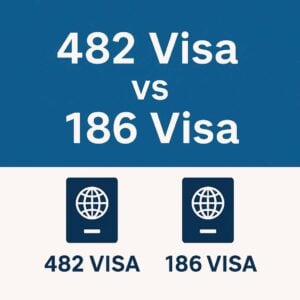
The Difference Between 482 & 186 Visa
Choosing the right employer-sponsored visa can be overwhelming.
This article is a general guide on how to choose between the 482 and 186 visas.
We’ll break down the key differences, eligibility requirements of the Subclass 482 (Temporary Skills Shortage) Visa and the Subclass 186 (Employer Nomination Scheme) Visa, and share insights from Nexor Group’s experience to help you decide which pathway may suit you best.
Understanding 482 and 186 Visas
Both the Subclass 482 and Subclass 186 visas require sponsorship from an eligible Australian employer.
-
The Subclass 482 (Skills in Demand) Visa is a temporary work visa that allows the nominated worker to work for the sponsoring employer in Australia for up to four years (five years for Hong Kong passport holders).
-
The Subclass 186 (Employer Nomination Scheme) Visa is a permanent work visa that allows the nominated worker to live and work in Australia indefinitely.
Each visa has different streams, catering to applicants’ skills, work experience, and salary levels.
Key Differences at a Glance
-
Temporary, up to 4 years (5 years for Hong Kong passport holders)
-
No age limit
-
At least 1 year of full-time relevant work experience in your nominated occupation or related field
-
Relevant skills assessment may be required depending on occupation and passport
-
English requirement depends on stream (see Home Affairs definitions)
-
Streams: Core Skills, Specialist Skills, Labour Agreement
-
Processing time: approx. 3–5 months (varies by stream)
-
Cost: from AUD 3,210
-
Permanent visa
-
Must be under 45 years of age (unless exempt)
-
Direct Entry stream: at least 3 years relevant work experience
-
Temporary Residence Transition stream: at least 2 years full-time sponsored employment on a 457 or 482 visa
-
Skills assessment generally required for Direct Entry; not required for TRT
-
Competent English required (unless exempt)
-
Streams: Direct Entry, Temporary Residence Transition, Labour Agreement
-
Processing time: approx. 12–18 months (Direct Entry), 14–18 months (TRT), 5–9 months (Labour Agreement)
-
Cost: from AUD 4,910
In summary, the main differences between the 482 and 186 visas include duration, eligibility requirements, processing times, and cost.
Importantly, the 186 TRT stream provides a permanent residency pathway for 482 visa holders.
When to Choose 482 vs 186 Visa
Both visas require employer sponsorship, but the right option depends largely on your work experience. Based on Nexor Group’s experience:
-
Scenario 1: You have at least 3 years of relevant full-time (or equivalent) skilled work experience, then you may be eligible for the 186 Direct Entry stream and can apply directly for permanent residency.
-
Scenario 2: You don’t yet meet the 3-year work experience requirement. In this case apply for a 482 visa as a stepping stone. After 2 years with your sponsoring employer on a 482 visa, you may be able to transition to the 186 TRT stream for permanent residency (provided all criteria are met).
Here at Nexor Group, our skilled immigration agents often see fresh graduates or career changers begin with a 482 visa, while skilled professionals with extensive experience usually find the 186 visa a better fit.
FAQs
Can I switch employers on a 482 visa?
Yes. 482 visa holders can leave their current employer and have 180 days to find a new sponsor. However, note that work experience requirements for 186 TRT must be under eligible sponsored employment.
Do I need a skills assessment for 482 or 186?
-
For the 482 visa, this depends on your occupation, nationality, and whether you’re exempt.
-
For the 186 visa, the Direct Entry stream generally requires it (unless exempt), while the TRT stream does not.
If my job isn’t on the Core Skills Occupation List, can I still apply for a 186 visa?
Possibly, through the 186 Labour Agreement stream or the TRT stream, provided you meet other eligibility requirements.
What happens if my 482 expires and I’m not yet eligible for the 186?
You may need to explore other visa options to gain more work experience, or consider the Labour Agreement stream if available.
How long does processing take?
-
482 visa: approx. 3–5 months (Core Skills), 19–85 days (Specialist Skills), 4–5 months (Labour Agreement)
-
186 visa: approx. 12–18 months (Direct Entry), 14–18 months (TRT), 5–9 months (Labour Agreement)
Can my family come with me under both visas?
Yes. Both the 482 and 186 visas allow family members to be included. For the 482 visa, your employer must be informed, and the timing of adding dependants is important. The 186 visa, as a permanent visa, also allows you to sponsor eligible family members.
Nexor Group
The subclass 482 and 186 visas are two of the most common employer-sponsored pathways in Australia.
While the 482 visa offers a temporary option with a pathway to permanency, the 186 visa provides direct permanent residency for those who meet the stricter requirements.
Nexor Group has helped thousands of clients navigate these pathways and secure the right visa for their circumstances. If you’re unsure which option is right for you, our migration team can guide you every step of the way. Get in touch today to see how we can help.
Book a Consultation Now
Book a Consultation Now
Latest Posts
Navigating the Australian Federal Budget: Implications for Migration
Navigating the Australian Federal Budget: Implications for Migration In response to a record surge…
The Top 20 Occupations On Demand: A Closer Look
The Top 20 Occupations On Demand: A Closer Look In the evolving employment landscape,…
Migration Planning for FY 23-24: The Key Takeaways
Migration Planning for FY 23-24: The Key Takeaways Australia has long been a popular destination…
Everything You Need to Know About the Updated 2023-24 State Nominated Migration Program
Everything You Need to Know About the Updated 2023-24 State Nominated Migration Program The awe-inspiring…
Tasmania’s State Nomination Program: What’s New for FY 23-24
Tasmania’s State Nomination Program: What’s New for FY 23-24 The Skilled Migration State Nomination Program…





